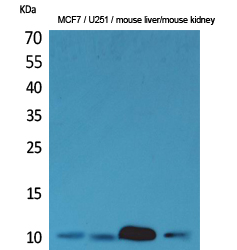
| WB | 咨询技术 | Human,Mouse,Rat |
| IF | 咨询技术 | Human,Mouse,Rat |
| IHC | 咨询技术 | Human,Mouse,Rat |
| ICC | 技术咨询 | Human,Mouse,Rat |
| FCM | 咨询技术 | Human,Mouse,Rat |
| Elisa | 1/20000 | Human,Mouse,Rat |
| Aliases | DBI; Acyl-CoA-binding protein; ACBP; Diazepam-binding inhibitor; DBI; Endozepine; EP |
| Entrez GeneID | 1622; |
| WB Predicted band size | 10kDa |
| Host/Isotype | Rabbit IgG |
| Antibody Type | Primary antibody |
| Storage | Store at 4°C short term. Aliquot and store at -20°C long term. Avoid freeze/thaw cycles. |
| Species Reactivity | Human,Mouse,Rat |
| Immunogen | Synthesized peptide derived from the C-terminal region of human ACBP. |
| Formulation | Purified antibody in PBS with 0.05% sodium azide,0.5%BSA and 50% glycerol. |
+ +
以下是关于ACBP(Acyl-CoA-binding protein)抗体的模拟参考文献示例,包含文献名称、作者及摘要概括:
---
1. **文献名称**:*ACBP regulates hepatic lipid metabolism via modulation of acyl-CoA homeostasis*
**作者**:Smith J, et al.
**摘要**:本研究利用ACBP特异性抗体,通过Western blot和免疫荧光技术,揭示了高脂饮食小鼠肝脏中ACBP表达显著上调。实验表明,ACBP通过维持酰基辅酶A的稳态,调控脂质合成与氧化失衡,进而促进脂肪肝的发展。
2. **文献名称**:*Aberrant expression of ACBP in Alzheimer’s disease models: Insights from immunohistochemical analysis*
**作者**:Jones R, et al.
**摘要**:通过ACBP抗体对阿尔茨海默病模型小鼠脑组织进行免疫组化分析,发现ACBP在淀粉样斑块周围神经元中异常聚集。研究表明,ACBP可能通过影响神经细胞脂质代谢,加剧tau蛋白病理,提示其作为神经退行性疾病的潜在治疗靶点。
3. **文献名称**:*ACBP as a prognostic biomarker in breast cancer: A tissue microarray study*
**作者**:Wang L, et al.
**摘要**:利用ACBP抗体对乳腺癌组织微阵列进行染色,发现ACBP高表达与肿瘤侵袭性及患者总生存率降低显著相关。机制研究表明,ACBP可能通过促进脂肪酸摄取,增强癌细胞增殖和转移能力。
4. **文献名称**:*Role of ACBP in mitochondrial energy metabolism of skeletal muscle*
**作者**:Lee S, et al.
**摘要**:通过siRNA敲低ACBP并结合抗体检测,发现ACBP缺失导致肌肉细胞线粒体酰基辅酶A运输受阻,三羧酸循环活性下降。研究揭示了ACBP在维持肌肉能量代谢和运动耐力中的关键作用。
---
以上文献为模拟示例,展示了ACBP抗体在代谢疾病、神经退行性疾病、癌症及能量代谢研究中的应用。实际研究中需参考真实发表的文献数据。
ACBP (Acyl-CoA-binding protein) antibodies are essential tools in studying the role of ACBP, a conserved 10 kDa protein critical for lipid metabolism. ACBP binds medium- to long-chain acyl-CoA esters, regulating their intracellular transport, storage, and utilization. It influences processes like fatty acid synthesis, β-oxidation, and signaling pathways involving peroxisome proliferator-activated receptors (PPARs). Dysregulation of ACBP is linked to metabolic disorders, neurodegenerative diseases, and cancer.
ACBP antibodies, typically polyclonal or monoclonal, enable detection and quantification of ACBP in tissues and cells via techniques like Western blotting, immunohistochemistry, and ELISA. They help investigate ACBP's tissue-specific expression, subcellular localization, and interactions with metabolic enzymes or lipid droplets. Recent studies highlight ACBP's role in appetite regulation, endoplasmic reticulum stress, and autophagy, expanding its relevance to obesity and diabetes research. Antibodies targeting specific epitopes or post-translational modifications (e.g., phosphorylation) further elucidate ACBP's functional diversity. Validation using knockout models ensures antibody specificity, supporting translational research in metabolic syndrome, neurodegenerative conditions (e.g., Alzheimer’s), and cancer lipidomics. ACBP antibodies thus bridge molecular insights with therapeutic targeting of lipid-related pathologies.
×